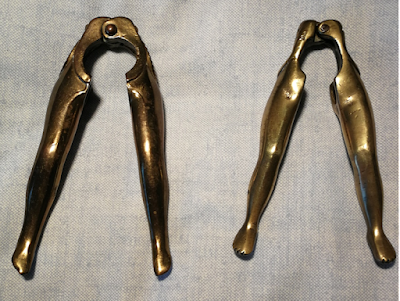21st February 2023………… the final post on my Leg blog. An appropriate date, because the first post was on 21st February 2021, and THIS anniversary post, which will include the remaining legs in my collection, will be No 43.
In fact, a few more stats!!
Yes, 43 posts in 24 months covering every one of the 169 legs in my collection and as near as dammit, with an average of 4 legs per post. The legs fell into 39 categories, and readers will know that 49 (over 25%) are Pipe Tampers.
Interestingly in 20 of the categories I only have one example, for example just 1
toothpick, 1 scribe, 1 Nail file etc.
Sadly my enthusiasm is not reflected in the number of hits
on my blog. 15 posts have been read by
no-one!!, and only Post No 1 got double figures…27. But I’ve enjoyed the
writing and nothing has swayed me from my believe that I am the only
Microtibialist in the world!! And as a final
statistic….I’ve written 32,000 words!!! And I estimate I have include over 150
photographs.
And so for the final curtain!! I’ve progressively eked out
the Pipe Tampers over 2 years but I am left with six, and this is a photo of
the group. None of them have any identification marks but there are some good
carving in the legs.
Starting from the left with number 1, I bought this leg in 2009 at the NEC. It is stock number 2 and was bought at the same time as No 1. That is where it all started!!
The leg is made of Ivory and whilst not hallmarked I believe
the unhatched top is silver. It was bought in the days when I did collect Ivory,
but I don’t buy ivory any more.
Next (no 2) is a small neat brass Tamper bought in 2015 at a
Stafford Fare. Not hatched but it is very tactile and described as a lady’s
tamper, with “a long sock!!”
Then No 3, a very small 19th century treen tamper,
with a gold coloured fringed cap.
Number 4 – again a simple Brass tamper, this time hatched to facilitate tobacco tamping. Bought in 2017 at the NEC.
Number 5 Brass and
Bronze can be confused especially with age but this one is brass. The visible
toes makes this a left leg, it is hatched, albeit very small and it has an
attractive curled top. Another from the NEC and dated 1880/90.
Finally No 6 is another of my favourites, the wrinkled Hunters
Boot. This one I feel sure is bronze and it is quite worn. Bought at a good
price!!, at Newark in 2022.
So that is the final Post of my leg collection. I have
enjoyed writing about all 169 legs in my collection and I am only sorry I did
not have more followers – just 127 Hits!!!.
This blog will stay live, and I will check periodically to see if there
is a resurgence!”!”!
Keep leg collecting…our time will come….. The hobby has been
on the Antique Road Show so anything is possible!!
David.
























